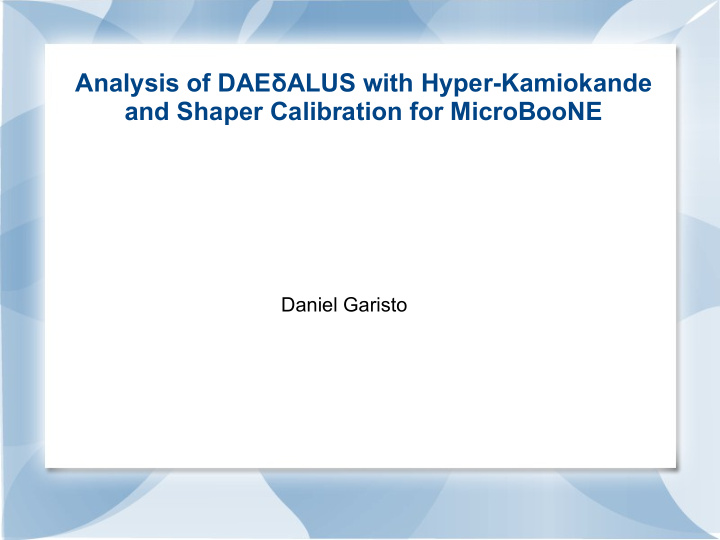



Analysis of DAEδALUS with Hyper-Kamiokande and Shaper Calibration for MicroBooNE Daniel Garisto
Overview What are neutrinos? Why do we look for neutrinos? MicroBooNE – Electronics DAEδALUS – Simulations
What are Neutrinos? • Postulated in 1930 by Wolfgang Pauli to explain missing energy, momentum, and spin in beta decay. • n 0 → p + + e - + ν e • Solar neutrino problem leads to neutrino oscillations (changes between flavor states of neutrinos). • If there are oscillations, neutrinos must move through time, and thus have mass.
How do we detect neutrinos? • Neutrinos only interact through the weak nuclear force(W+, W-, Z bosons). – Neutral Current(Z): neutrino imparts energy and momentum. – Charged Current(W+,W-): neutrino is transformed into its partner lepton. • Detectors either use metal calorimeters, or are filled with liquid and PMTs to detect light from interactions.
Why do we care? • Solar neutrinos can tell us about the inside of the sun. • They can warn us about supernovae. • Our understanding of how the universe works on the most basic level. • CP violation (in leptons) would indicate why we’re made of matter, and not antimatter.
MicroBooNE Precedent: Low energy excess from LSND and MiniBooNE, inability to differentiate between electron and photon events. Design: Liquid Argon TPC(Time Projection Chamber). Detection via PMTs and wire planes.
Shaper role • Shaper receives analog pulses of electricity from the PMTs and integrates over the pulse width. – This smoothes the signal and removes noise, for better analysis. • Our goal: Calibrate the software functions we use to interpret the shaper, so the readout is as accurate and precise as possible.
How to calibrate • Send a simulated PMT pulse to the shaper, receive data. (10000 events on 9 amplitudes in 16 channels). Data is put into binary files, and then converted to .root files. • We use ROOT to examine peak height and sum charge to estimate their energy. Then we plot the mean sum charge and mean peak height against the input amplitude to check linearity.
DAEδALUS Decay at rest Experiment for δ cp studies at the Laboratory • for Underground Science. • Use new cyclotron technology to create high intensity of neutrinos to interact with detectors to investigate δ cp . – Muon antineutrinos to electron antineutrinos; value of δ cp indicated by difference in oscillation events between distances. • Proposed experiment needs verification and support for monetary backing.
GLoBES
Simulations • The first order of business is making sure that GLoBES has accurate experiment files. • I’m checking my results against Professor Shaevitz’s Fortran results.
Simulations pt.2 The red line is DAEδALUS, which my results are beginning to match the pattern of. It’s quite rough, but promising.
The Future! • Additional GLoBES simulations: • Investigation of inverse mass hierarchy • Potential sterile neutrinos incorporated into analysis • Many, many years down the road: Maybe they’ll build DAEδALUS!
Acknowledgements Thanks to everyone at Nevis Labs, but in particular: Vic Genty, who was more than happy to help me in shaper calibration. Georgia Karageorgi and Kazuhiro Terao who, I am convinced, know everything. Rachel Carr, for her excellent documentation, without which I would be nowhere. Mike Shaevitz, who was horrifyingly patient with my many deficiencies and slowness. And finally, Vesna Gasperov and the SRF Program.
Recommend
More recommend